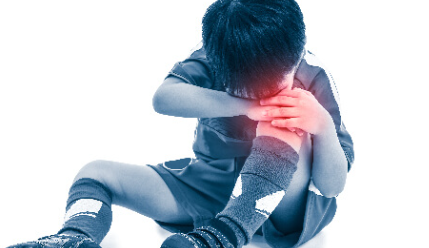Introduction to Pediatric Fibromyalgia
Fibromyalgia is commonly associated with adults, particularly women, but children and adolescents can also develop this complex and chronic condition. When it affects younger individuals, it is often referred to as juvenile fibromyalgia. Although it is less prevalent in children, the impact is just as profound, often interfering with education, physical activity, and emotional development.
The symptoms of fibromyalgia in kids are not always easy to identify. Many of them overlap with other pediatric conditions or may be dismissed as growing pains, anxiety, or fatigue. As a result, children with fibromyalgia often endure their symptoms in silence, struggling without the proper diagnosis or support. Understanding how fibromyalgia manifests in kids is essential for parents, educators, and healthcare providers who play a vital role in early intervention.
Chronic Widespread Pain in Children
The most prominent symptom of fibromyalgia in children is persistent, widespread musculoskeletal pain. Unlike localized pain from injury, this discomfort affects multiple parts of the body without a specific cause. Kids may describe the pain as aching, burning, or throbbing, and it may migrate from one area to another.
Pain is usually worse in the morning and after physical activity. Common areas include the back, legs, arms, and shoulders. Since young children might struggle to articulate their discomfort, they might use vague terms like sore, tired, or hurting all over, leading adults to overlook the severity.
Extreme Fatigue and Low Energy
Persistent fatigue is another hallmark symptom. Children with fibromyalgia often wake up feeling unrefreshed even after a full night’s sleep. They may appear sluggish during the day, have trouble staying alert in class, or prefer to rest rather than participate in play or sports.
This type of exhaustion is not resolved by naps or weekends off and may fluctuate without obvious reasons. As a result, fatigue can lead to reduced academic performance and social withdrawal.
Cognitive Issues or Fibro Fog
Cognitive impairment, commonly known as fibro fog, is not exclusive to adults. Kids with fibromyalgia may experience problems with concentration, memory, and processing information. They might forget assignments, struggle with reading comprehension, or take longer to complete homework.
Teachers may misinterpret these symptoms as inattention or lack of effort. However, the root cause lies in neurological dysfunction associated with fibromyalgia, not laziness or behavior issues.
Heightened Sensitivity to Stimuli
Children with fibromyalgia often report heightened sensitivity to physical sensations such as touch, noise, bright lights, smells, and changes in temperature. This heightened sensitivity can make typical classroom environments overwhelming.
For example, they may find the hum of fluorescent lights or the pressure of a backpack uncomfortable. Even being gently tapped on the shoulder might cause them to wince or recoil, as their nervous systems are hypersensitive to stimuli.
Unrefreshing and Disturbed Sleep
Sleep disturbances are common among kids with fibromyalgia. Many have difficulty falling asleep, staying asleep, or reaching deep stages of rest. Nighttime restlessness, tossing and turning, and frequent awakenings are typical complaints.
These disruptions can lead to daytime fatigue, mood swings, and worsened pain perception. A child may seem irritable or moody after what appears to be a full night of sleep, puzzling caregivers unaware of the sleep quality issue.
Emotional Distress and Mood Changes
Children with fibromyalgia are at a higher risk of developing emotional and psychological challenges. Anxiety and depression are frequently reported, often due to chronic pain, fatigue, and isolation from peers who do not understand their experience.
Mood swings, irritability, low self-esteem, and a sense of frustration can be evident. Some children may withdraw socially, avoid participating in extracurricular activities, or express feelings of sadness or worthlessness.
Gastrointestinal Complaints
Many children with fibromyalgia also experience gastrointestinal problems such as stomachaches, bloating, constipation, or diarrhea. These symptoms often mimic those of irritable bowel syndrome, which is frequently seen alongside fibromyalgia.
Dietary sensitivities may contribute, although formal food allergies are not always present. The connection between the gut and the nervous system, often referred to as the gut-brain axis, is believed to play a role in these symptoms.
Morning Stiffness and Physical Discomfort
Children may experience stiffness in their joints and muscles upon waking or after sitting for long periods. This stiffness can make it difficult to get out of bed, dress, or move around comfortably in the morning.
They may complain of tight or sore muscles even after light activity. This can affect physical education participation or make them appear inactive, which sometimes leads to mislabeling by instructors or caregivers.
Headaches and Migraines
Headaches, including migraines, are another common symptom among kids with fibromyalgia. These headaches may be frequent, severe, and long-lasting, often occurring alongside sensitivity to light and sound.
Children may miss school or become unable to concentrate due to the intensity of their headaches. Stress, fatigue, and sensory overload can act as triggers, exacerbating the condition.
Behavioral Changes and Academic Challenges
The cumulative effect of pain, fatigue, cognitive dysfunction, and emotional struggles often leads to noticeable changes in behavior. Children may become less engaged, more dependent, or easily frustrated. Their academic performance may suffer, not because of lack of intelligence, but due to the physical and mental toll of the condition.
Misinterpretation of these behaviors can delay diagnosis and add to the child’s stress. Support from school counselors, understanding teachers, and healthcare providers is critical in these situations.
Social Isolation and Peer Difficulties
Fibromyalgia can isolate children from their peers. They may be unable to keep up physically or emotionally with their classmates, leading to feelings of alienation. Peer misunderstandings, teasing, or exclusion can worsen the child’s mental health and deepen the sense of not belonging.
Early intervention with open communication and inclusive activities can help children with fibromyalgia feel supported and involved.
FAQs on Symptoms of Fibromyalgia in Kids
1. Can children really have fibromyalgia?
Yes, although it is less common, children and teens can develop fibromyalgia, often referred to as juvenile fibromyalgia.
2. What are the first signs of fibromyalgia in children?
Widespread pain, extreme fatigue, and frequent complaints of stomachaches or headaches are often early signs.
3. How is fibromyalgia diagnosed in children?
There is no single test. Diagnosis is made by ruling out other conditions and evaluating symptoms that persist for at least three months.
4. Can stress trigger symptoms in kids?
Yes, emotional and environmental stressors can exacerbate symptoms, especially pain and fatigue.
5. Do kids with fibromyalgia need special education support?
Many benefit from accommodations like reduced homework, extra time on tests, and physical breaks during the day.
6. Is fibromyalgia in children lifelong?
While it is chronic, some children experience improvement over time, especially with proper management and support.
Conclusion
Recognizing the symptoms of fibromyalgia in kids is essential for early diagnosis and compassionate care. The condition, though invisible, can severely impact a child’s physical, emotional, and social well-being. By understanding the unique ways it presents in young people, families and educators can provide the support needed to improve outcomes and preserve a child’s confidence and quality of life.



